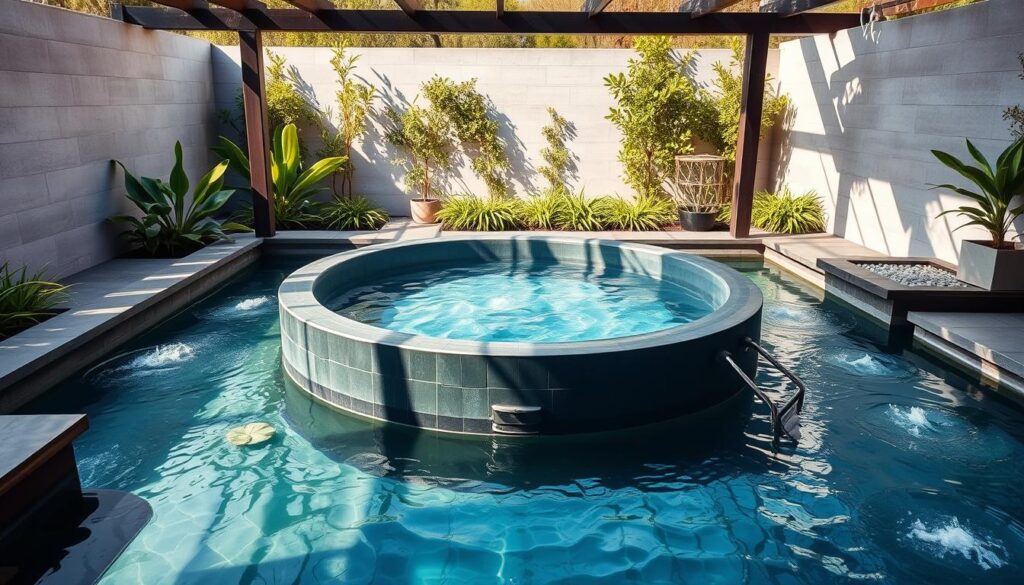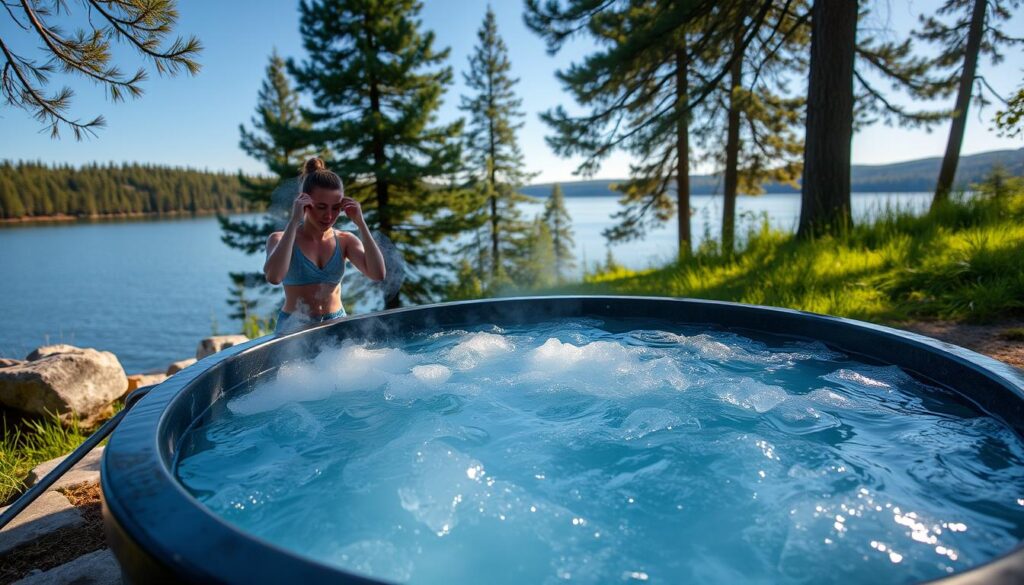Have you ever wondered why high-performing individuals like CEOs, entrepreneurs, and celebrities are taking the plunge into icy cold water? This latest fitness craze, known as cold plunging, is taking the wellness world by storm. But is it just another passing fad, or does this extreme cold exposure practice offer genuine benefits for your workout recovery, mental health, and overall well-being? Let’s dive in and explore the science behind this increasingly popular trend.
Key Takeaways
- Cold plunging, or immersing the body in ice-cold water, is a surging fitness trend among high achievers and wellness enthusiasts.
- Potential benefits of cold plunge therapy include improved workout recovery, better metabolic health, and enhanced mental resilience.
- The scientific evidence on the effectiveness of cold plunging is still emerging, with more research needed to support the health claims.
- Proper safety precautions and gradual acclimation are crucial when incorporating cold plunge therapy into your routine.
- Cold showers can offer similar benefits as cold plunging, providing a more accessible alternative for those new to the practice.
What is Cold Plunge Therapy?
Cold plunge therapy, also known as cold water immersion, is a growing fitness trend that involves submerging your body in cold water, typically between 50-60°F, for short periods. This practice can range from a quick dip in an icy lake to a prolonged soak in a cold tub filled with ice cubes. The popularity of cold plunging has skyrocketed, with Google searches for the term increasing 14-fold from early 2022 to 2023, and 19% of surveyed participants reporting they would likely participate or have tried it.
Definition and Background
The concept of using cold water for therapeutic purposes is not new. The ancient Greeks and even historical figures like Thomas Jefferson have long recognized the potential benefits of cold water exposure. However, the recent surge in popularity can be attributed to advocates like Wim Hof, who have brought cold plunge therapy into the mainstream fitness scene.
Cold plunging is often seen as a form of cold therapy, which can be practiced in various ways, from taking a cold shower to immersing oneself in an icy lake or tub. The potential benefits of this practice range from improved recovery and metabolic health to enhanced mental well-being and stress resilience.
| Trend Indicator | Data |
|---|---|
| Google search increase | 14-fold from early 2022 to 2023 |
| Percentage of surveyed participants | 19% reported they would likely participate or have tried cold plunging |
| TikTok hashtag views | Over 1 billion views for #coldplunge |
The rise in popularity of cold plunge therapy can also be observed on social media, with the hashtag #coldplunge on TikTok amassing over a billion views, showcasing the significant interest in this fitness trend among the general public, as well as among celebrities, athletes, and influencers.
Benefits of Cold Plunge Therapy
The potential benefits of cold plunge therapy are quite promising, though the research is still evolving. While more studies are needed, preliminary data suggests that this novel recovery technique may provide several advantages for your physical and mental well-being.
Muscle Soreness and Recovery
One of the primary benefits of cold plunge therapy is its ability to reduce muscle soreness and support faster recovery. A 2012 study found that cold water immersion within 2 to 24 hours after exercise can aid in reducing muscle soreness and promote faster recovery of muscle strength, power, and neuromuscular function.
The mechanism behind this is thought to be related to the constriction and dilation of blood vessels, which can help reduce inflammation and swelling in the muscles. However, it’s important to note that if your goal is to build strength and increase muscle mass, the same anti-inflammatory effects that curb soreness may also blunt the processes that contribute to muscle hypertrophy.
Immune Function and Metabolic Health
- Cold plunge therapy may have anti-inflammatory effects, potentially contributing to a stronger immune system over time.
- Regular cold exposure could also modulate hormone levels, impacting hormones such as cortisol, testosterone, and estrogen, with potential benefits for metabolic health.
- Cold exposure may increase insulin sensitivity, potentially enhancing glucose utilization and blood sugar control.
Mental Health and Stress Resilience
Cold plunge therapy may also offer mental health benefits. The release of endorphins and dopamine during cold water immersion can promote feelings of well-being and relaxation, potentially aiding in managing anxiety and depression. Additionally, the regulatory effects on the body’s circadian rhythms and the release of adrenaline and norepinephrine may lead to improved sleep quality.
While the research on the potential benefits of cold plunge therapy is promising, it’s essential to approach this practice with caution and consult healthcare professionals, especially if you have any underlying health conditions. Proper safety precautions and a gradual introduction to cold exposure are crucial to minimize risks and maximize the potential benefits.
Cold Plunge Therapy and Exercise Recovery
When it comes to post-workout recovery, cold plunge therapy can be a double-edged sword. While it may help curb muscle soreness and inflammation, the potential benefits may not align with all of your fitness goals.
Studies have shown that cold water immersion can decrease muscle soreness, creatine kinase levels, and perceived recovery for up to 24 hours after exercise. This is particularly beneficial for athletes engaged in back-to-back training sessions or competitions, as it can help manage the body’s inflammatory response.
However, the same mechanisms that provide relief from muscle soreness may also blunt the processes that contribute to muscle hypertrophy and strength gains. For individuals focused on resistance training and building muscle mass, cold plunging may not be the ideal recovery strategy, especially if performed immediately after a workout.
A more balanced approach is to reserve cold plunges for cardio or rest days, or to wait at least four hours after a resistance training session before indulging in a cold soak. This can help harness the anti-inflammatory benefits without compromising muscle-building adaptations.
Ultimately, the role of cold plunge therapy in exercise recovery should be considered within the broader context of an individual’s fitness goals and overall health. As with any recovery modality, it’s essential to listen to your body and find the right balance that supports your long-term performance and well-being.
Cold Plunge Therapy: Mental Health and Stress Resilience
Emerging research suggests that cold plunge therapy may offer promising benefits for mental health and stress resilience. A 2018 case study detailed the effects of regular cold water swimming on a 24-year-old woman with major depressive disorder and anxiety, and she was able to manage her symptoms without medication after four months. Experts theorize that these mental health improvements may be attributed to the release of feel-good neurochemicals like beta-endorphins, dopamine, and serotonin triggered by cold exposure.
Further studies have found that the biological adaptations you undergo when regularly exposed to cold could improve your body’s response to stress, potentially curbing downstream psychological symptoms like depression and anxiety. Consistent full-body cold water immersion has shown potential benefits in decreasing cortisol levels, enhancing mood regulation, and increasing stress resilience.
For example, research involving undergraduate students indicated that a 20-minute dip in cold sea water (13.6°C, 56.5°F) led to significant decreases in negative emotions like tension, anger, depression, fatigue, and confusion, while boosting positive emotions such as vigor and self-esteem. Another study concluded that cortisol levels did not significantly increase during cold water immersion but decreased after a one-hour session in water temperatures ranging from 14°C (57°F) to 32°C (90°F).
Cold water immersion also triggers the release of endorphins to reduce pain and boost well-being, and elevates noradrenaline levels, aiding in stress management and enhancing energy and focus. While the long-term effects on endorphin levels vary among individuals, noradrenaline levels continue to increase with regular practice, potentially improving mental health and stress resilience over time.

“Consistent full-body cold water immersion has shown potential benefits in decreasing cortisol levels, enhancing mood regulation, and increasing stress resilience.”
However, it’s important to note that cold plunging may not be suitable for everyone, particularly those with heart conditions, as it can trigger a powerful cold-shock response and increase the risk of drowning if done alone. Experts recommend starting with short sessions of 30 seconds or less and gradually increasing the time spent in the cold water, with an optimal water temperature range of 45°F (7°C) to 65°F (18°C) for safe and effective immersion.
Cold Plunge Therapy and Metabolic Health
The allure of cold plunge therapy goes beyond just physical recovery and mental resilience. Emerging research suggests this trendy fitness practice may also hold promising benefits for your metabolic health.
One of the fascinating potential effects of cold exposure is its impact on your metabolic rate. Studies have found that as little as five minutes of immersion in water below 59°F (15°C) can trigger a measurable increase in metabolic activity. This metabolic boost may be linked to the body’s efforts to maintain its core temperature, driving the burning of more calories and energy.
But the benefits may extend even deeper. Cold temperatures appear to stimulate the production and activity of brown adipose tissue, often referred to as “brown fat.” Unlike the more common white fat that stores excess calories, brown fat is rich in mitochondria and actively burns energy to generate heat. Researchers believe this brown fat activation from cold exposure could help improve blood sugar regulation and insulin sensitivity, potentially reducing the risk of conditions like diabetes.
“There is rising evidence supporting the health benefits of cold water exposure, including effects on the immune system, cardiovascular system, insulin sensitivity, and mental health,” states Dr. James Mercer, lead author of a recent review on the topic.
While the research is still unfolding, the prospect of cold plunge therapy supporting overall metabolic health is an intriguing avenue worth exploring. As always, it’s best to consult with your healthcare provider before embarking on any new fitness or wellness regimen, especially if you have pre-existing medical conditions.
Incorporating cold plunge therapy into your routine may offer a multifaceted approach to optimizing your metabolic function, blood sugar control, and overall cardiometabolic well-being. As with any health and fitness practice, moderation and gradual acclimation are key to safely unlocking the potential benefits.
Risks and Safety Considerations
While cold plunge therapy offers potential benefits, it also carries certain risks that individuals must be aware of and take precautions against. Sudden exposure to cold water can trigger a “cold shock” response, leading to increased heart rate, blood pressure spikes, and impaired cognitive function. Prolonged immersion in cold water can also result in hypothermia, a dangerous condition that can cause organ failure if left unchecked.
In addition, the physical incapacitation experienced during cold water immersion increases the risk of drowning. This is particularly concerning for those with pre-existing medical conditions, such as cardiovascular events or respiratory issues, as the stress on the body can exacerbate these conditions.
- Cold shock response can trigger increased heart rate and blood pressure, potentially leading to life-threatening situations.
- Hypothermia can occur due to prolonged exposure to cold water, causing symptoms like shivering and confusion, which can lead to organ failure.
- Skin and nerve damage, such as cold panniculitis and nerve damage, are potential risks from direct contact with cold water.
- Individuals with certain health conditions, like heart disease, high blood pressure, and Raynaud’s syndrome, face higher risks during cold plunge activities.
- Drowning is a risk associated with cold water immersion, particularly if the gasp reflex is uncontrollable, leading to suffocation.
To ensure safety, it is crucial to consult a healthcare professional before engaging in cold plunge therapy, especially for those with pre-existing medical conditions. Gradual acclimation to cold water, monitoring water temperature, and having a supervised session are also recommended practices to minimize the risks associated with this activity.
“Safety should always be the top priority when it comes to cold water therapy. Individuals need to listen to their bodies and consult with medical professionals to ensure they can participate safely and reap the potential benefits without jeopardizing their health.”
Cold Plunge Therapy: Latest Fitness Trend Explained
The cold plunge trend has taken the fitness world by storm, with social media platforms like TikTok and Instagram showcasing the craze. Celebrities like Lizzo and Harry Styles have helped propel the popularity of this ancient therapy, leaving many curious about its potential benefits and risks.
From the ancient Greeks to historical figures like Thomas Jefferson, cold water immersion has been used for therapeutic purposes for centuries. However, the current surge in interest has led to a demand for scientific evidence on the impact of this practice.
According to recent data, nearly one million posts on Instagram feature the #coldplunge tag, while TikTok’s #coldplunge videos have accumulated over 900 million views. This widespread popularity suggests that the cold plunge trend is more than just a passing fad.
Potential Benefits of Cold Plunge Therapy
- Cold water immersion can reduce delayed-onset muscle soreness compared to resting after a workout.
- Cold exposure can alleviate inflammation and reduce joint pain while possibly reducing systemic inflammation in the long term.
- Cold water immersion may increase dopamine levels by up to 250%, potentially leading to decreased depression and anxiety symptoms.
- Hormetic stressors like cold plunging prompt cellular processes that enhance health, slow aging, and improve stress resilience.
However, it’s important to note that cold plunging may not be suitable for individuals with certain medical conditions, and it is recommended to start slowly and gradually increase the duration and intensity of the practice.
“A five-minute cold plunge made participants feel more alert and less stressed or nervous.”
As the cold plunge trend continues to gain traction, the demand for scientific research and guidance on incorporating this therapy into a healthy lifestyle will likely continue to grow.
Incorporating Cold Plunge Therapy into Your Routine
Tips and Recommendations
Embarking on a cold plunge routine requires gradual acclimation to build tolerance to frigid temperatures. Experts advise beginners to start with no more than 10 to 15 minutes of cold exposure, gradually increasing the duration as your body adapts. While there’s no standard temperature, most participants report using water ranging from 38 to 60 degrees Fahrenheit, with the optimal range being 50 to 59 degrees Fahrenheit for reducing muscle soreness.
It’s crucial to always have someone present during your cold plunge and to consult your doctor before starting the practice, especially if you have any underlying health conditions. Conditions like cardiovascular disease, hypertension, Reynaud’s syndrome, pregnancy, high blood pressure, heart disease, circulatory problems, low baseline body temperature, or pacemakers may require medical supervision.
| Recommendation | Details |
|---|---|
| Duration | Start with 10-15 minutes and gradually increase as tolerance builds |
| Water Temperature | 50-59 degrees Fahrenheit (10-15 degrees Celsius) |
| Frequency | 2-3 sessions per week, with rest days in between |
| Safety | Always have someone present and consult a doctor before starting |
By incorporating these tips and recommendations into your routine, you can safely and effectively reap the benefits of cold plunge therapy, such as faster recovery, reduced muscle soreness, and improved overall well-being.

Future Research on Cold Plunge Therapy
As the popularity of cold plunge therapy continues to rise, researchers are optimistic that upcoming studies will provide more clarity on the health benefits of this trending fitness practice. However, much of the current information is based on ongoing research and clinical trials, rather than robust scientific evidence. Some of the prevalent beliefs about cold plunging are still ahead of what we actually know through rigorous scientific research.
One such study, the “Sea Swimming for Treatment of Depression and Anxiety” clinical trial, aims to explore the potential mental health benefits of cold water exposure. By conducting more definitive research, the scientific community hopes to gain a deeper understanding of how cold plunge therapy may impact conditions like depression and anxiety.
As the fascination with cold plunging continues to grow, researchers are eager to uncover the physiological mechanisms behind the claimed health advantages. Upcoming studies and clinical trials will likely shed more light on the therapeutic applications of this emerging fitness trend, providing a stronger foundation for its widespread adoption.
| Key Findings from Ongoing Research |
|---|
| – Cold plunging typically involves immersing oneself in water around 10°C (50°F) for short periods. |
| – Exposure to cold water has been shown to increase white blood cell count, enhancing the immune system. |
| – Cold exposure can trigger hormonal responses believed to aid in fat metabolism. |
| – Regular cold immersion significantly reduces muscle soreness after workouts, improving recovery speed. |
As the scientific community continues to investigate the potential benefits of cold plunge therapy, we can expect to see more robust and conclusive findings in the coming years. These ongoing research efforts and clinical trials will undoubtedly shape our understanding of this emerging fitness trend and its scientific evidence-based therapeutic applications.
Conclusion
The summary of key points regarding cold plunge therapy, or the practice of immersing oneself in icy water, highlights its growing popularity as a fitness trend in recent years. While the research on the potential benefits of cold plunging is still emerging, there is promising data suggesting it may help reduce muscle soreness, inflammation, and swelling, as well as potentially support a healthy metabolism, immune system, and mental health.
However, the existing evidence is still inconclusive, and more robust studies are needed to fully understand the therapeutic applications of this practice. It’s important for individuals interested in trying cold plunging to do so gradually, under the guidance of a healthcare professional, and to be aware of the potential risks, such as hypothermia and cardiovascular events.
As the popularity of cold plunge therapy continues to rise, particularly among fitness enthusiasts, wellness influencers, and entrepreneurs, it will be crucial to stay informed on the latest research and to approach this practice with caution and consideration for personal health and safety.










